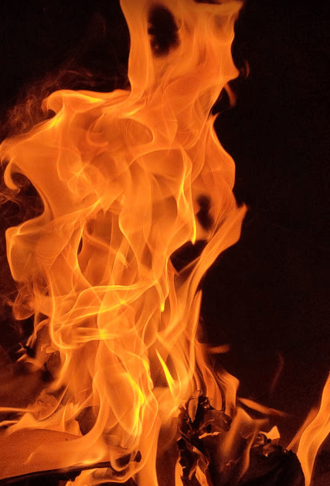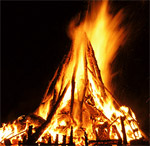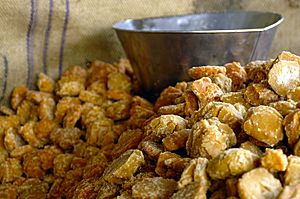Lohri facts for kids
Quick facts for kids Lohri |
|
|---|---|

Lohri Bonfire
|
|
| Also called | Lal Loi |
| Observed by | People of North India: Punjab, Jammu, Haryana and Himachal Pradesh by Punjabis, Dogras, Haryanvis, and Himachalis |
| Type | Religious, cultural |
| Significance | Midwinter festival, celebration of winter solstice |
| Celebrations | Bonfire, song (Bhangra and Gidda) |
| Date | Lua error in Module:Wikidata at line 132: attempt to index field 'wikibase' (a nil value). |
| Frequency | Once in a year |
| Related to | Dulla Bhatti |
Lohri is a popular winter festival from Punjab. It is mainly celebrated in North India. Many stories and legends are linked to this festival. People believe Lohri marks the end of the shortest day of the year, called the winter solstice.
Lohri celebrates the end of winter. It welcomes longer days and the sun moving towards the northern part of the world. The festival happens the night before Maghi, also known as Makar Sankranti. It usually falls around January 13th each year.
Lohri is an official holiday in Punjab, the Jammu region of Jammu and Kashmir, and Himachal Pradesh. It is also celebrated in Delhi and Haryana. People of different faiths, like Hindus, Sikhs, Christians, and Muslims, celebrate Lohri. In Punjab, Pakistan, it is not an official holiday. However, Hindus, Sikhs, and some Muslims celebrate it in villages and cities like Faisalabad and Lahore.
Contents
When is Lohri Celebrated?
Lohri is connected to the Vikrami calendar. It is celebrated the day before Maghi. Maghi is known as Makar Sankranti in other parts of India.
Lohri falls in the month of Paush. This is based on the solar part of the Punjabi calendar. Most years, it happens around January 13th on the Gregorian calendar.
The Story of Lohri
People have written about Lohri for a long time. European visitors saw it being celebrated in the 1800s. For example, a visitor named Wade saw Maharaja Ranjit Singh celebrating it in 1832. Another person, Captain Mackeson, noted that the Maharaja gave gifts on Lohri day in 1836.
The celebration of a big bonfire at night was also seen in the royal court in 1844. These old writings do not explain how the festival started. But there are many folk tales about Lohri.
Lohri celebrates the arrival of longer days. This happens after the winter solstice, the shortest day of the year. Long ago, Lohri was celebrated when the winter solstice ended. It marks the sun's journey north, making days longer. The day after Lohri is called Maghi Sangrand.
Lohri is an old mid-winter festival. It began in areas near the Himalayan mountains. Winters there are colder than in other parts of India. Hindus and Sikhs traditionally lit bonfires in their yards. They did this after finishing their Rabi season farm work. They gathered around the fire, sang, and danced. This marked the end of winter and the start of longer days.
Punjabis celebrate Lohri on the last day of the month when the winter solstice occurs. This is different from the exact day of the solstice. Lohri remembers the passing of the shortest day of winter.
Why Lohri is Important
Lohri is an old festival linked to the winter harvest season. It is especially important in the Punjab region. A popular story connects Lohri to a hero named Dulla Bhatti.
Many Lohri songs tell the tale of Dulla Bhatti. He was a local hero in Punjab during the time of Emperor Akbar. Dulla Bhatti was known for rescuing Punjabi girls. These girls were being taken to be sold in slave markets. Among the girls he saved were two named Sundri and Mundri. They became famous in Punjabi folk tales.
During Lohri celebrations, children go to homes singing traditional songs. The songs often mention Dulla Bhatti. One child sings, and others shout "Ho!" after each line. After the song, adults give snacks and money to the children. Lohri also marks the start of the harvest season and sunny days.
How Lohri is Celebrated
People celebrate Lohri by lighting bonfires. They eat special festive foods, dance, and collect gifts. If a family has recently had a wedding or a new baby, their Lohri celebrations are even more exciting.
Many people in North India celebrate Lohri at home. They perform special Lohri rituals. Singing and dancing are a big part of the fun. People wear their brightest clothes. They dance the bhangra and gidda to the beat of the dhol drum. Everyone sings Punjabi songs and enjoys themselves.
A traditional Lohri dinner often includes Sarson da saag (mustard greens) and makki di roti (cornbread). Lohri is very important for farmers. But people in cities also celebrate it. It is a great chance to spend time with family and friends.
Bonfires and Festive Foods
Lohri is celebrated with a bonfire. Lighting a bonfire during this winter festival is a very old tradition. Ancient people lit fires to welcome the return of longer days.
In Punjab, people eat roasted corn from the new harvest during Lohri. The January sugarcane harvest is also celebrated. Sugarcane products like gurh (jaggery) and gachak (a sweet made from jaggery and nuts) are important. Nuts, which are harvested in January, are also central to the celebrations.
Another important food is radish, harvested between October and January. Mustard greens are grown in winter and are also a winter food. It is traditional to eat Gajak, Sarson da saag with Makki di roti, radish, peanuts, and jaggery. People also eat "til rice." This dish is made by mixing jaggery, sesame seeds, and puffed rice. Sometimes, this snack is called "Tilcholi."
Special Dances in Jammu
Lohri in Jammu has extra traditions. These include making and dancing with Chajja, performing the Hiran Dance, and making Lohri garlands. Young children make a peacock replica called a Chajja. They carry this Chajja and go from house to house celebrating Lohri.
In Jammu, a special Hiran Dance is performed. Some houses that have had happy events prepare special foods. Children wear garlands made of peanuts, dry fruits, and candies on Lohri day.
Collecting Lohri Treats
In some parts of Punjab, about 10 to 15 days before Lohri, groups of young boys and girls go around. They collect logs for the Lohri bonfire. In some places, they also collect grains and jaggery. These are sold, and the money is shared among the group.
In some areas of Punjab, boys play a "trick or treat" game. They choose one boy to smear his face with ash and tie a rope around his waist. This boy acts as a warning for people who do not give Lohri items. The boys sing Lohri songs asking for treats. If they don't get enough, they give a warning. If still not enough is given, the boy with the ash on his face might try to enter the house and break clay pots.
Lohri Traditions
During the day, children visit homes singing songs. They receive sweets, snacks, and sometimes money. It is considered bad luck to send them away empty-handed. If a family has new newlyweds or a new baby, they expect more treats.
The treats collected by the children are called Lohri. They include sesame seeds, gachchak, crystal sugar, gur (jaggery), moongphali (peanuts), and phuliya (popcorn). These treats are shared at night during the festival. Sesame seeds, peanuts, popcorn, and other foods are also thrown into the bonfire. For some, throwing food into the fire means burning the old year. It marks the start of the new year on Makar Sankranti.
The bonfire is lit at sunset in the main village area. People throw sesame seeds, jaggery, sugar-candy, and rewaries into the fire. They sit around it, sing, and dance until the fire goes out. Some people pray and walk around the fire. This shows respect for fire, a common tradition in winter solstice celebrations.
It is traditional to offer guests sesame seeds, gachchak, jaggery, peanuts, and popcorn. Hindus also pour milk and water around the bonfire. This is to thank the Sun God and ask for his continued protection.
Among some Sindhi communities, Lohri is called Lal Loi. On Lal Loi, children bring wooden sticks from their grandparents and aunts. They light a fire at night and enjoy dancing and playing around it. This festival is becoming more popular among other Sindhis too.
Lohri Songs
There are many Lohri songs. Here is an example of a song that thanks Dulla Bhatti:
Sunder mundriye ho!
Tera kaun vicharaa ho!
Dullah Bhatti walla ho!
Dullhe di dhee vyayae ho!
Ser shakkar payee ho!
Kudi da laal pathaka ho!
Kudi da saalu paata ho!
Salu kaun samete!
Chacha gali dese!
Chache choori kutti! zamidara lutti!
Zamindaar sudhaye!
Bum Bum bhole aaye!
Ek bhola reh gaya!
Sipahee far ke lai gaya!
Sipahee ne mari itt!
Paanvey ro te paanvey pitt!
Sanoo de de Lohri, te teri jeeve jodi!
Translation
Beautiful girl
Who will think about you
Dulla of the Bhatti clan will
Dulla's daughter got married
He gave one ser of sugar!
The girl is wearing a red suit!
But her shawl is torn!
Who will stitch her shawl?!
The uncle made choori!
The landlords looted it!
Landlords are beaten up!
Lots of simple-headed boys came!
One simpleton got left behind!
The soldier arrested him!
The soldier hit him with a brick!
(Cry or howl)!
Give us Lohri, long live your pair (to a married couple)!
Whether you cry, or bang your head later!
Another lovely Lohri song is 'Tode upper Toda, Tode upper Saag'. Children sing this when they go to ask for Lohri treats from neighbors. This folk song is sung in Jammu.
Toda!
Tode upar saag.
Saag!
Saag wich mirch!
Mirch!
Mirch lgi kodi.
Kodi!
Deyo sanu lohri.
Toda!
Tode upar saag.
Saag!
Saag wich mirch!
Mirch!
Mirch lgi kodi.
Kodi!
Deyo sanu lohri.
Similar Winter Festivals Around the World
Winter solstice festivals are celebrated in many ways around the world. The festival of Yule is part of Christmas celebrations. A log is burned to remember the winter solstice.
The festival of Hogmanay is celebrated on New Year's Day in Scotland. The fire festival of Stonehaven is like the old winter solstice bonfires. Another event happens on January 11th in Burghead. A flaming barrel, called a Clavie, is carried around. It is then placed on Doorie Hill to burn out. People take the glowing embers for good luck in the new year.
Images for kids





